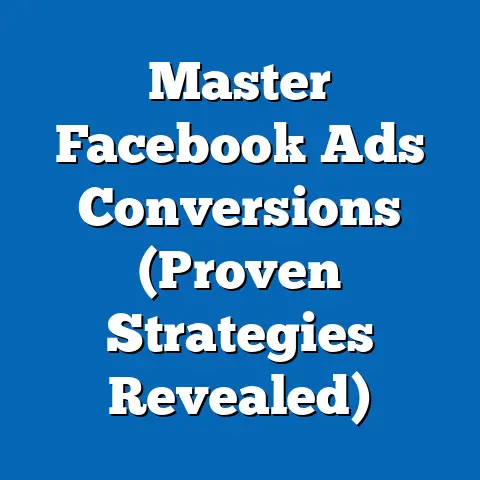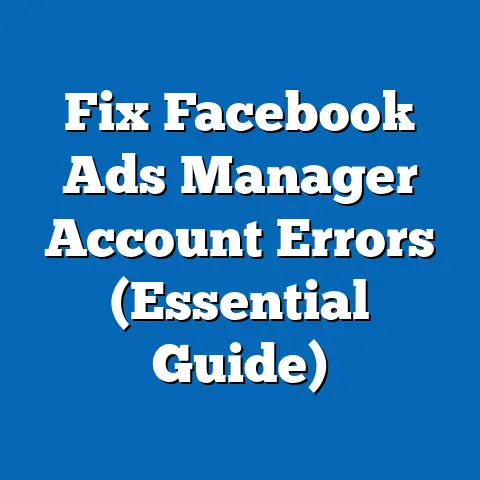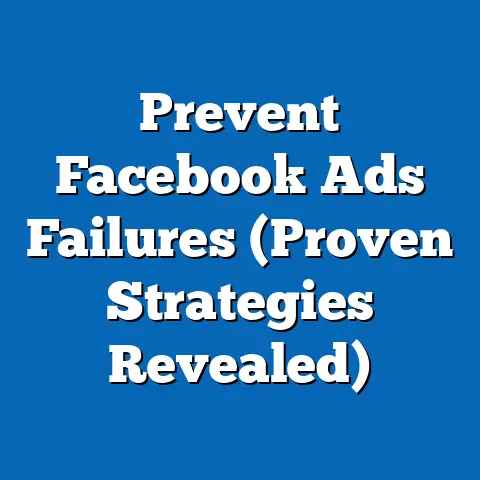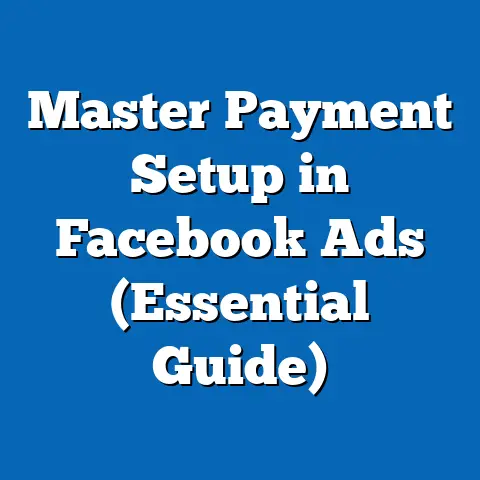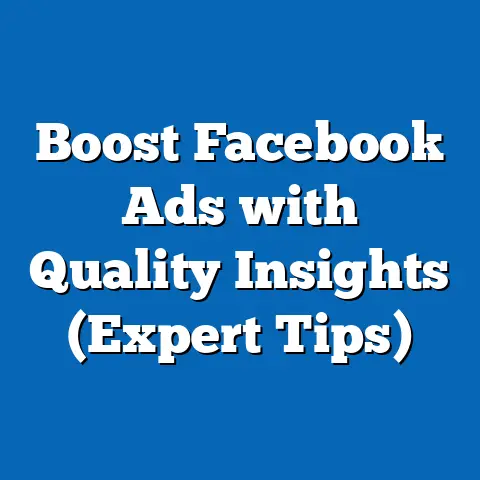Unlock Profits with Facebook Ad Affiliate Marketing (Expert Tips)
Why did the marketer break up with the calendar? Because they felt like they were just going through the motions! Jokes aside, if your marketing feels like a chore, it’s time to inject some excitement and profit potential into your strategy. And that’s exactly what I’m going to help you do with Facebook Ad Affiliate Marketing.
Facebook Ad Affiliate Marketing holds incredible promise for those looking to generate income online. In this article, I’m going to share expert tips and strategies that will help you navigate the landscape of Facebook Ads, select the right affiliate programs, craft compelling ads, target your audience effectively, track your performance, and scale your efforts. Get ready to unlock your profit potential!
Understanding Facebook Ad Affiliate Marketing
What is Facebook Ad Affiliate Marketing?
Facebook Ad Affiliate Marketing is a powerful strategy that combines the vast reach and precise targeting capabilities of Facebook Ads with the revenue-generating potential of affiliate marketing. Simply put, it’s using paid advertising on Facebook to promote products or services that you don’t own, and earning a commission for every sale or lead generated through your unique affiliate link.
Think of it this way: you’re a digital matchmaker, connecting potential customers with products they need, and getting paid for the successful connection. Instead of creating your own products or managing inventory, you leverage the existing products of other businesses.
I’ve seen firsthand how this model can be a game-changer for aspiring entrepreneurs. It eliminates the barriers to entry associated with traditional business models, allowing you to start earning income with minimal upfront investment.
Why is it Effective?
Facebook Ads offer several advantages that make them an ideal platform for affiliate marketers:
- Massive User Base: With billions of active users, Facebook provides unparalleled reach to connect with potential customers worldwide.
- Precise Targeting: Facebook’s sophisticated targeting options allow you to narrow down your audience based on demographics, interests, behaviors, and more, ensuring your ads reach the most relevant prospects. I’ve been able to target my audiences down to specific interests like “organic gardening” or “gluten-free baking,” leading to much higher conversion rates.
- Engagement Potential: Facebook’s interactive ad formats, such as video ads, carousel ads, and lead generation ads, enable you to engage with your audience in meaningful ways and drive them toward conversion.
- Measurable Results: Facebook Ads Manager provides detailed analytics that allow you to track your ad performance, identify what’s working, and optimize your campaigns for maximum ROI.
Success Stories
The proof is in the pudding, as they say. Here are a few brief success stories that highlight the potential of Facebook Ad Affiliate Marketing:
- Case Study 1: E-commerce Niche: A blogger in the home organization niche used Facebook ads to promote affiliate products on Amazon and saw a 300% increase in sales within two months.
- Case Study 2: Software as a Service (SaaS) Niche: An affiliate marketer promoting a project management software saw a 150% increase in qualified leads by using Facebook Ads to target small business owners and freelancers.
- Statistics: According to a recent report, affiliate marketing spending in the U.S. is projected to reach \$8.2 billion by 2022, with a significant portion of that attributed to social media advertising, including Facebook Ads.
Takeaway: Facebook Ad Affiliate Marketing is a powerful and effective strategy for generating income online. It leverages the reach and targeting capabilities of Facebook Ads to promote affiliate products and earn commissions on sales or leads.
Setting Up for Success
Choosing the Right Niche
Selecting the right niche is crucial for success in affiliate marketing. Your niche should be:
- Profitable: Conduct market research to identify niches with high demand and decent commission rates. Look for products or services that solve a problem or fulfill a need.
- Aligned with Your Interests: Choose a niche that you’re passionate about or knowledgeable about. This will make it easier to create engaging content and connect with your audience authentically. I once tried promoting a product I wasn’t interested in, and it showed in my ads. The results were dismal.
- Targetable: Ensure that your chosen niche has a defined target audience that can be effectively reached through Facebook Ads.
Tips for Niche Research:
- Use Keyword Research Tools: Tools like Google Keyword Planner, SEMrush, or Ahrefs can help you identify popular keywords and assess the competition in different niches.
- Explore Affiliate Networks: Browse affiliate networks like Amazon Associates, ShareASale, or Commission Junction to discover trending products and commission rates in various niches.
- Analyze Competitors: Identify successful affiliate marketers in your chosen niche and analyze their strategies, including their ad campaigns, content marketing efforts, and target audience.
Selecting Affiliate Programs
Once you’ve chosen a niche, it’s time to select affiliate programs that offer:
- Competitive Commissions: Look for programs that offer commission rates that are worth your time and effort.
- High-Quality Products: Promote products or services that you believe in and that offer real value to your audience.
- Reputable Brands: Partner with reputable brands that have a strong track record of customer satisfaction and ethical business practices.
- Reliable Tracking and Reporting: Ensure that the affiliate program provides accurate tracking and reporting of your sales and commissions.
Tips for Evaluating Affiliate Programs:
- Read Reviews: Research the affiliate program and read reviews from other affiliates to assess its reputation and reliability.
- Test the Products: If possible, test the products or services yourself to ensure they meet your standards and are worth promoting.
- Check the Terms and Conditions: Carefully review the terms and conditions of the affiliate program to understand the commission structure, payment terms, and any restrictions on advertising or promotion.
Creating a Facebook Business Account
To run Facebook Ads, you’ll need to create a Facebook Business Account. This account allows you to manage your ad campaigns, track your performance, and access advanced features.
Steps to Create a Facebook Business Account:
- Go to business.facebook.com and click “Create Account.”
- Enter your business name, select a primary page (or create a new one), and provide your contact information.
- Add your payment information to fund your ad campaigns.
- Grant permissions to team members or agencies who will be managing your ads.
Tips for Professional Branding:
- Use a Professional Profile Picture: Upload a high-quality logo or headshot that represents your brand.
- Create a Compelling Cover Photo: Design a visually appealing cover photo that showcases your brand’s mission or values.
- Fill Out Your Business Information: Provide accurate and complete information about your business, including your website, contact information, and business hours.
Understanding Facebook Ad Policies
Before launching any ad campaigns, it’s crucial to familiarize yourself with Facebook’s advertising policies. Violating these policies can result in your ads being disapproved, your account being suspended, or even permanently banned from the platform.
Key Facebook Ad Policies to Be Aware Of:
- Misleading or Deceptive Content: Avoid making false claims or exaggerating the benefits of the products or services you’re promoting.
- Prohibited Products or Services: Facebook prohibits the promotion of certain products or services, such as illegal drugs, firearms, and tobacco products.
- Inappropriate Content: Avoid using offensive or discriminatory language, imagery, or content in your ads.
- Personal Attributes: Do not target ads based on sensitive personal attributes, such as race, ethnicity, religion, or sexual orientation.
Tips for Staying Compliant:
- Review Facebook’s Advertising Policies Regularly: Facebook’s policies are subject to change, so it’s important to stay updated on the latest guidelines.
- Use the Facebook Ads Library: Use the Facebook Ads Library to see examples of ads that have been approved by Facebook and to identify any potential issues with your own ads.
- Contact Facebook Support: If you’re unsure whether your ad complies with Facebook’s policies, contact Facebook Support for clarification.
Takeaway: Setting up for success in Facebook Ad Affiliate Marketing involves choosing the right niche, selecting affiliate programs with competitive commissions and high-quality products, creating a professional Facebook Business Account, and understanding Facebook’s advertising policies.
Crafting Compelling Ads
Writing Engaging Copy
Your ad copy is your opportunity to grab the attention of potential customers and persuade them to click on your ad. Here are some tips for crafting engaging copy:
- Know Your Audience: Understand your target audience’s needs, pain points, and motivations. Tailor your ad copy to resonate with their specific interests and concerns.
- Highlight the Benefits: Focus on the benefits of the product or service you’re promoting, rather than just the features. Explain how it will solve their problems or improve their lives.
- Use Strong Calls to Action: Include clear and compelling calls to action that tell people what you want them to do, such as “Shop Now,” “Learn More,” or “Get a Free Trial.”
- Create a Sense of Urgency: Use language that creates a sense of urgency or scarcity, such as “Limited Time Offer” or “While Supplies Last.”
- Incorporate Emotional Triggers: Tap into your audience’s emotions by using language that evokes feelings of excitement, happiness, or fear of missing out (FOMO).
Using Eye-Catching Visuals
Visuals play a crucial role in capturing attention and conveying your message effectively. Here are some tips for using eye-catching visuals:
- Use High-Quality Images or Videos: Use images or videos that are visually appealing, well-lit, and relevant to the product or service you’re promoting.
- Show the Product in Action: If possible, show the product or service in action, demonstrating how it works and the benefits it provides.
- Use Bright Colors and Contrasting Elements: Use bright colors and contrasting elements to make your visuals stand out and grab attention.
- Incorporate Text Overlays: Use text overlays to highlight key benefits, calls to action, or promotional offers.
- Optimize for Mobile: Ensure that your visuals are optimized for mobile devices, as the majority of Facebook users access the platform on their smartphones.
A/B Testing Ads
A/B testing, also known as split testing, is the process of testing different versions of your ads to see which performs better. By A/B testing your ads, you can identify the most effective elements and optimize your campaigns for maximum ROI.
Elements to Test:
- Headlines: Test different headlines to see which ones grab the most attention and drive the most clicks.
- Images or Videos: Test different visuals to see which ones resonate most with your audience.
- Ad Copy: Test different variations of your ad copy to see which ones generate the most engagement and conversions.
- Targeting Options: Test different targeting options to see which audiences are most responsive to your ads.
- Calls to Action: Test different calls to action to see which ones drive the most clicks and conversions.
Tips for A/B Testing:
- Test One Element at a Time: To accurately measure the impact of each element, test only one element at a time.
- Use a Control Group: Create a control group that receives the original version of your ad, and then test different variations against the control.
- Track Your Results: Use Facebook Ads Manager to track your results and identify which variations are performing better.
- Iterate Based on Data: Use the data you collect to refine your ad strategies and optimize your campaigns for better performance.
Takeaway: Crafting compelling ads involves writing engaging copy, using eye-catching visuals, and A/B testing your ads to identify the most effective elements and optimize your campaigns for maximum ROI.
Targeting Your Audience
Understanding Facebook Audience Insights
Facebook Audience Insights is a powerful tool that allows you to learn more about your target audience, including their demographics, interests, behaviors, and more. By understanding your audience, you can create more targeted and effective ad campaigns.
How to Use Facebook Audience Insights:
- Go to Facebook Audience Insights.
- Select a target audience, such as “Everyone on Facebook” or a custom audience based on your website visitors or email list.
- Explore the different tabs to learn more about your audience’s demographics, interests, behaviors, and purchase habits.
- Use the insights you gain to refine your targeting options and create more relevant ads.
Utilizing Custom Audiences
Custom audiences allow you to target your ads to specific groups of people based on their past interactions with your business. You can create custom audiences based on:
- Website Visitors: Target people who have visited your website or specific pages on your website.
- Email Lists: Upload your email list to target people who have subscribed to your newsletter or purchased from you in the past.
- Engagement: Target people who have engaged with your Facebook page, ads, or videos.
- App Users: Target people who have downloaded or used your mobile app.
Effective Audience Targeting Strategies
Here are some expert tips for effective audience targeting:
- Start with Broad Targeting: Begin with broad targeting options and then narrow down your audience based on the data you collect.
- Use Layered Targeting: Use layered targeting options to target people who meet multiple criteria, such as demographics, interests, and behaviors.
- Experiment with Lookalike Audiences: Create lookalike audiences based on your existing customers or website visitors to target people who are similar to your best customers.
- Exclude Irrelevant Audiences: Exclude irrelevant audiences from your targeting to avoid wasting your ad spend on people who are unlikely to convert.
- Monitor Your Results: Continuously monitor your results and refine your targeting options based on the data you collect.
Takeaway: Targeting your audience effectively involves understanding Facebook Audience Insights, utilizing custom audiences, and implementing effective audience targeting strategies.
Tracking Performance and Optimizing Campaigns
Setting Up Facebook Pixel
The Facebook Pixel is a small piece of code that you place on your website to track conversions and gather data on your ad performance. By setting up the Facebook Pixel, you can:
- Track Conversions: Track the actions that people take on your website after clicking on your ad, such as making a purchase, filling out a form, or subscribing to your newsletter.
- Optimize Your Ads: Use the data you collect to optimize your ad campaigns for maximum ROI.
- Retarget Website Visitors: Retarget people who have visited your website with relevant ads.
- Create Lookalike Audiences: Create lookalike audiences based on your website visitors to target people who are similar to your best customers.
Steps to Set Up the Facebook Pixel:
- Go to Facebook Events Manager.
- Click “Connect Data Sources” and select “Web.”
- Choose “Facebook Pixel” and click “Connect.”
- Name your pixel and enter your website URL.
- Choose how you want to install the pixel code: manually, using a partner integration, or by emailing instructions to a developer.
- Verify that the pixel is installed correctly by using the Facebook Pixel Helper Chrome extension.
Analyzing Key Metrics
To effectively optimize your ad campaigns, it’s important to monitor key performance metrics, such as:
- Click-Through Rate (CTR): The percentage of people who click on your ad after seeing it. A higher CTR indicates that your ad is relevant and engaging to your audience.
- Conversion Rate: The percentage of people who take a desired action after clicking on your ad, such as making a purchase or filling out a form. A higher conversion rate indicates that your landing page is effective and that your offer is compelling.
- Cost Per Click (CPC): The average cost you pay for each click on your ad. A lower CPC indicates that your ad is efficient and that you’re targeting the right audience.
- Cost Per Acquisition (CPA): The average cost you pay for each conversion. A lower CPA indicates that your ad campaign is profitable and that you’re generating a good return on your investment.
- Return on Ad Spend (ROAS): The amount of revenue you generate for every dollar you spend on advertising. A higher ROAS indicates that your ad campaign is highly profitable.
Iterating Based on Data
The key to successful Facebook Ad Affiliate Marketing is to continuously iterate based on the data you collect. By analyzing your key metrics, you can identify what’s working, what’s not working, and make adjustments to your ad strategies to improve your performance.
Tips for Iterating Based on Data:
- Track Your Results Regularly: Monitor your key metrics on a daily or weekly basis to identify trends and potential issues.
- Experiment with Different Strategies: Don’t be afraid to experiment with different strategies, such as targeting options, ad creatives, and bidding strategies, to see what works best for your audience.
- Use A/B Testing: Use A/B testing to compare different versions of your ads and identify the most effective elements.
- Adjust Your Budget: Adjust your budget based on the performance of your ad campaigns. If a campaign is performing well, consider increasing your budget to reach more people. If a campaign is not performing well, consider decreasing your budget or pausing the campaign.
- Stay Updated on Facebook’s Best Practices: Facebook’s advertising platform is constantly evolving, so it’s important to stay updated on the latest best practices and guidelines.
Takeaway: Tracking performance and optimizing campaigns involves setting up the Facebook Pixel, analyzing key metrics, and iterating based on data to refine your ad strategies and improve your performance.
Scaling Your Efforts
Expanding Ad Reach
Once you’ve identified successful ad campaigns, you can scale your efforts to reach a wider audience and generate more revenue. Here are some strategies for expanding your ad reach:
- Increase Your Budget: Increasing your budget will allow you to reach more people and generate more clicks and conversions.
- Expand Your Targeting Options: Expand your targeting options to include new demographics, interests, and behaviors.
- Create Lookalike Audiences: Create lookalike audiences based on your existing customers or website visitors to target people who are similar to your best customers.
- Use Automatic Placements: Use automatic placements to allow Facebook to show your ads on the most effective platforms, such as Facebook, Instagram, and Audience Network.
Diversifying Traffic Sources
While Facebook Ads can be a powerful source of traffic, it’s important to diversify your traffic sources to reduce your reliance on a single platform. Here are some ways to diversify your traffic:
- Email Marketing: Build an email list and send out regular newsletters or promotional emails to your subscribers.
- Content Marketing: Create valuable and engaging content, such as blog posts, articles, or videos, to attract organic traffic to your website.
- Social Media Marketing: Promote your content and affiliate links on other social media platforms, such as Twitter, LinkedIn, or Pinterest.
- Influencer Marketing: Partner with influencers in your niche to promote your products or services to their followers.
Continuously Learning and Adapting
The world of digital marketing is constantly changing, so it’s important to continuously learn and adapt to stay ahead of the curve. Here are some ways to stay updated on the latest trends and best practices:
- Read Industry Blogs and Publications: Subscribe to industry blogs and publications to stay informed about the latest trends and best practices in Facebook Ads and affiliate marketing.
- Attend Conferences and Webinars: Attend conferences and webinars to learn from industry experts and network with other marketers.
- Join Online Communities: Join online communities and forums to connect with other marketers and share your experiences.
- Experiment with New Strategies: Don’t be afraid to experiment with new strategies and technologies to see what works best for your business.
Takeaway: Scaling your efforts involves expanding your ad reach, diversifying traffic sources, and continuously learning and adapting to stay ahead of the curve.
Conclusion
In this article, I’ve shared expert tips and strategies for unlocking profits with Facebook Ad Affiliate Marketing. We’ve covered everything from understanding the basics of Facebook Ads and affiliate marketing to setting up for success, crafting compelling ads, targeting your audience effectively, tracking your performance, optimizing your campaigns, and scaling your efforts.
Remember, success in Facebook Ad Affiliate Marketing requires strategy, continuous improvement, and a willingness to learn and adapt. By implementing the tips shared in this article, you can take the first step in unlocking your profit potential with Facebook Ads.
Now, it’s time for you to take action! Start by choosing a profitable niche, selecting reputable affiliate programs, creating a professional Facebook Business Account, and crafting compelling ads that resonate with your target audience. Track your performance, optimize your campaigns, and scale your efforts to generate a steady stream of income through Facebook Ad Affiliate Marketing. Good luck, and happy marketing!

